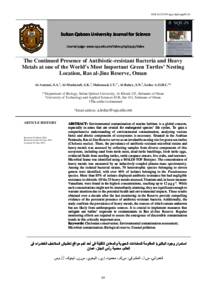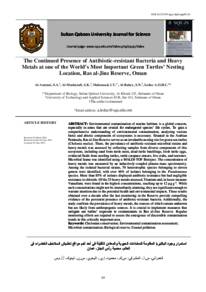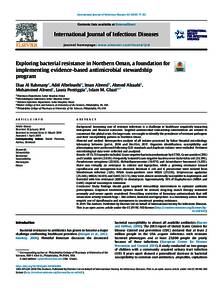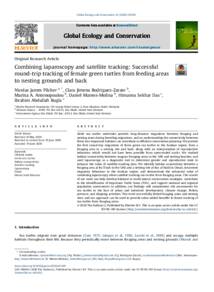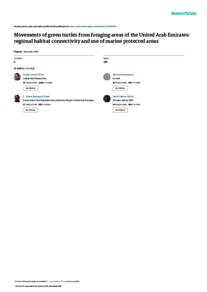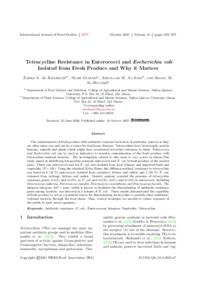Document
The continued presence of antibiotic-resistant bacteria and heavy metals at one of the world’s most important green turtles’ nesting location, Ras al-Jinz Reserve, Oman.
Identifier
DOI:10.53539/squjs.Splisspp69-81
Source
Sultan Qaboos University Journal for Science, v. 29, no. 2, p. 69-81.
Contributors
Al-Musharafi, S. K., Author
Mahmoud, I. Y., Author
Al-Bahry, S. N., Author
Leduc, A. O. H. C, Author
Other titles
استمرار وجود البكتيريا المقاومة للمضادات الحيوية والمعادن الثقيلة في أحد أهم مواقع تعشيش السلاحف الخضراء في العالم، محمية رأس الجنز، عمان.
Country
Oman.
City
Muscat
Publisher
College of Science, Sultan Qaboos University.
Gregorian
2024-08-16
Language
English
English abstract
Environmental contamination of marine habitats is a global concern,
especially in areas that are crucial for endangered species’ life cycles. To gain a
comprehensive understanding of environmental contamination, analyzing various
biotic and abiotic components of ecosystems is necessary. Situated in the Arabian
Peninsula, Ras al-Jinz Reserve serves as an invaluable nesting site for green sea turtles
(Chelonia mydas). There, the prevalence of antibiotic-resistant microbial strains and
heavy metals was assessed by collecting samples from diverse components of this
ecosystem, including sand from turtle nests, dead turtle hatchlings, fresh turtle eggs,
oviductal fluids from nestling turtles, turtle carapace smears, live crabs, and seawater.
Microbial fauna was identified using a MALDI-TOF Biotyper. The concentration of
heavy metals was measured by an inductively-coupled plasma mass spectrometry.
Among the isolated bacterial strains, 70 heterotrophic species belonging to eleven
genera were identified, with over 46% of isolates belonging to the Pseudomonas
species. More than 85% of isolates displayed antibiotic resistance but had negligible
resistance to chloride. Of the 23 heavy metals assessed, Titanium and, in lesser measure
Vanadium, were found in the highest concentrations, reaching up to 12 µg g-1. While
such concentrations might not be immediately alarming, they are significant enough to
warrant attention due to the potential health and environmental impacts. These results
obtained over a decade after the last monitoring in the Reserve provide compelling
evidence of the persistent presence of antibiotic-resistant bacteria. Additionally, the
study confirms the prevalence of heavy metals, the sources of which remain unknown
but are likely from anthropogenic sources. It is crucial to implement measures that
mitigate sea turtles’ exposure to contaminants in Ras al-Jinz Reserve. Regular
monitoring efforts are required to assess the emergence of discernible contamination
trends in this critically important area.
ISSN
Online: 2522-2279
Print: 2312-1270
Arabic abstract
يشكل التلوث البيئي للموائل البحرية مصدر قلق عالمي، وخاصة في المناطق ذات الأهمية لدورات حياة الأنواع المهددة بالانقراض. للحصول على فهم شامل للتلوث البيئي، من الضروري تحليل المكونات الحيوية وغير الحيوية المختلفة للنظم البيئية. تقع محمية رأس الجنز في شبه الجزيرة العربية، وهي بمثابة موقع تعشيش لا يقدر بثمن للسلاحف البحرية الخضراء (Chelonia mydas). هناك، تم تقييم مدى انتشار السلالات الميكروبية المقاومة للمضادات الحيوية والمعادن الثقيلة من خلال جمع عينات من مكونات متنوعة لهذا النظام البيئي، بما في ذلك الرمال من أعشاش السلاحف، وصغار السلاحف الميتة، وبيض السلاحف الطازج، وسوائل المبيض من السلاحف المعششة، ومسحات درع السلاحف، والسرطانات الحية، ومياه البحر. تم تحديد الفونا الميكروبية باستخدام جهاز MALDI-TOF Biotyper، وتم قياس تركيز المعادن الثقيلة باستخدام مطياف الكتلة البلازمية المقترنة. من بين السلالات البكتيرية المعزولة، تم تحديد 70 نوعًا غيري التغذية تنتمي إلى أحد عشر جنسًا، حيث كانت أكثر من 46% من العزلات تنتمي إلى Pseudomonas spp. أظهر أكثر من 85% من العزلات مقاومة للمضادات الحيوية، ولكن كانت لديهم مقاومة ضئيلة للكلوريد. ومن بين الـ 23 معدنًا ثقيلًا تم تقييمها، كان التيتانيوم، وبدرجة أقل الفاناديوم، الأعلى تركيزًا، حيث وصلت إلى 12 ميكروغرام لكل جرام. على الرغم من أن هذه التركيزات قد لا تكون مقلقة على الفور، إلا أنها تستدعي الاهتمام بسبب التأثيرات الصحية والبيئية المحتملة. توفر هذه النتائج، التي تم الحصول عليها بعد مرور عقد من المراقبة الأخيرة في المحمية، دليلاً دامغًا على الوجود المستمر للبكتيريا المقاومة للمضادات الحيوية. بالإضافة إلى ذلك، تؤكد الدراسة انتشار المعادن الثقيلة، التي لا تزال مصادرها مجهولة ولكن يُعتقد أنها من مصادر بشرية. من الضروري تنفيذ تدابير للحد من تعرض السلاحف البحرية للملوثات في محمية رأس الجنز، إلى جانب جهود مراقبة منتظمة لتقييم الاتجاهات المستقبلية في هذه المنطقة المهمة.
Category
Journal articles

